Bonjour, you. I have something different for us this week, a collective newsletter I am inviting you to take in slowly, a celebration of food as a journey to reconcile with who we are and how we root ourselves in the world; how we eat to belong; how we nourish communities. Please accept this week’s newsletter as my introvert’s book launch party too, as today is the publication of the paperback edition of Breaststrokes*, my second novel and a book I couldn’t have written in isolation. The relationship between the words and the narrative arc of a story is its subject and much writing was done via listening indeed.
So, last month, I asked writers and artists to tell me what they would choose to cook for their younger selves. Most of them I have never met in person but I often seek out their work, catching up with their newsletters as a remedy for loneliness, exchanging words in passing, pinning their illustrations on my fridge, dropping a heart emoji underneath an Instagram post or elsewhere. I gave them no restrictions – no format, no word-count, no age range; I told them they didn't have to cook, they could refuse to cook themselves something – because I wanted these entries to be plural, human, rather than curated. Eleven of them answered – Alycia, Apoorva, Clare, Devin, Hannah, Isabela, Nina, Reena, Sarah, Stefanie, Steph – and I am so grateful they allowed me to share their emails with you today. What follows are après-ski, exorcism and cookbook talks, as well as memories of wide-legged jeans and tree spinach, thoughts on carbs and noodles, booze and beans, some recipes and much more.
Your story is valid.
margaux
*available in all, good bookshops such as Bookshop.Org, The Portobello Bookshop and Waterstones.
Alycia
When I visit home (“home”), there are two things that I can always count on: 1) my wonder at seeing the endless flat Albertan prairies, and 2) my parents’ cooking.
Beyond that, a lot has changed in the last year. My mom moved out of the townhouse I called home for longer than any of my other homes. Now when I visit, I no longer drive down Whitemud at night, the highway that’s often enrobed in a deep darkness unique to the prairies. I no longer take the 34th street exit onto the route that I drove every day for years. I can picture it still. A sharp left turn, a playground zone, a grassy field, a cluster of evergreen trees that almost look like a forest, a duplex with its garden of lilies, and the four-way stop just before our street.
I was young when I lived there and I never paid much attention to our kitchen. Now it’s seeping out of my memory forever: that messy, chaotic, tiny space where so much of my life happened without me realising it was happening. The place where my parents showed me and my siblings love through food and where we all lingered to catch up, to argue, to snack secretly (in my case), to take photos, to celebrate birthdays, and so much more.
Cooking has never interested me, even though both my parents are so good at it. They owned a restaurant in a small northern town when I was a kid, and they know how to make everything perfectly – whether the East African-Asian fusion dishes passed down to them, or the handmade pizzas that I devoured growing up. My lack of interest translated into a lack of skill.
In Germany last year, when my friends Nina, Pratyusha, Jessica and I went on a writing residency together, food became one of the major strands of our project. Not just in our writing, but in how we connected with each other. Every day, the morning table was bright with our spread of soft boiled eggs, bread and jam, carafes of coffee, soy milk, and fruit. J made white spargel, freshly bought from a little stall in Brandenburg, with hollandaise for our first night. P made a delicious omelette the morning after she arrived. And N’s noodle soup was (predictably) divine. We chopped mushrooms in the kitchen, peeled eggs with our legs dangling into the turquoise Liepnitzsee, and picnicked on the bank of Hellsee next to wildflowers. Early on, when we were planning our meals, I disclosed I couldn’t cook very well. Amongst our intimate quartet, this admission felt a little more heartbreaking than usual – similar, somehow, to the feeling of acknowledging a lost language.
Food is so entwined with culture. We learn about each other, ourselves, our histories, and our families through the visceral and embodied act of cooking and eating. Ingredients and recipes reveal migration patterns. Most of what I ate growing up resembled a variety of South Asian dishes, this knowledge crossing the Indian Ocean with my ancestors. But because my parents were born in Dar es Salaam, our recipes are influenced by East African vegetation and traditions too. This also resembles the mixing and mingling of our language(s).
In the summer of 2020, when all of us were grappling with a new way of alienated life, I texted my mom on WhatsApp and asked her how to make samosas. Both of my sisters – older and younger – make complicated and rewarding meals often, and they’re always exchanging recipes and kitchen tips in our group chat. I stay quiet and appreciative in those moments. During lockdown, I didn’t learn how to make bread or keep a sourdough starter in my fridge. My partner and I cycled through many of the same meals we always ate, and in fact, the monotony was exacerbated by less frequent and larger grocery trips to the (big) Tesco. But I did, for some reason, feel the compulsion to finally buy my very own cumin and turmeric (yes, I didn’t own these before), and reach out to my mom about this single recipe.
(Admitting this in writing is, strangely enough, a little scary. Food is so entwined with identity and community. It links me with other South Asians in the diaspora. To articulate all of this makes me feel deficient, or like a stranger, in some ways.)
Our traumas from that period of course remain, but this was one of my fond memories of that time. My mom replied first through text with a scattering list of ingredients, broken up in a few different messages, and interspersed with my sisters’ commentary. She (of course) included no quantities at all, so I had to press her for those. And of all our calls that summer, it’s the subsequent video chat that stays with me the most. The pot sizzled on the stove, ingredients fusing together to make a delicious, spicy, filling, while my mom and sisters laughed sweetly at my attempts. Something had to go wrong. I bought the wrong wraps, but to this day, I claim this has less to do with my incompetence and more to do with what’s available in the main Edinburgh grocery stores.
I think during that time of upheaval and forced isolation, I wanted more than anything to connect with a younger version of myself, a version that felt – if not exactly safe – held by my family. And in a family like mine, where our gatherings orbit around a meal, where our love for each other complements our palates, the kitchen easily becomes a kind of portal. In acts of making, I can cross the threshold and enter the past.
When I make the samosas this time, I pull up the old recipe from a folder of images from five years ago. I had taken a screenshot of the messages, and I’m pulled back not only to the physical movement of cooking, but to the conversations we had as our younger selves. I thought a lot has changed over the last year, but a lot has changed in the last five years. It startles me. Our griefs and our joys look very different, maybe deeper and darker like the prairies at night. I also realise the quantities are still missing and I do my best to approximate, my guesswork based on muscle memory and the beautiful vision I have etched in my mind of that sizzling pan.
Alycia Pirmohamed is a poet based in Edinburgh. She is the author of Another Way to Split Water, and she writes elsewheres, discontinuous notes on poetry, on Substack.
Apoorva
My offering to you for this project is okra, which I made as a 13 year old with my cousin for the first time in my mother's and grandmother's kitchen. This was my first time cooking, my first time at the stove, and we drowned the okra in oil, which rendered the vegetable unpalatable. I still have a hard time eating the vegetable unless it's deep fried, black, and crisp. And so, I'm not technically cooking this for my younger self as much as exorcising the ghost of the bad okra that I made.
Okra: an exorcism
A lingering memory of okra in oil
floating, sinking, moribund strung together
through gloop and slime, faces resembling aliens
tough as the fibres of hemp the greens take on the taste
of malaise, my limp teenage offering down the drain for
the sake of others while I search for closure – the okra is small and forgotten
(and so am I), I fall to my knees to know the dirt, to know the unblemished earth
that made me eat my words instead.
Apoorva is a writer and editor and writes shelf offering on Substack, featuring essays on food and culture and around food and culture.
Clare
When I started cross-country skiing last winter, my head filled with fantasies about cooking elaborate après-ski meals for myself and my friend Sara. In my head, we would take in the fresh air, pushing ourselves through the trails in a city park. Our cheeks pink with invigoration from the movement, we would return to my home for a hearty meal: I imagine juicy mushrooms wrapped in my own hand-laminated puff pastry; potatoes roasted with garlic and rosemary; warmed marinated olives; a small wheel of the lusciously earthy and funky Upland’s Rush Creek Reserve cheese, a Wisconsin winter delicacy; a baguette; and a fortifying red wine with notes of plum and black pepper fill the table. My cozy apartment is transformed into a ski lodge in these daydreams, the wood floors and crown molding rendered cozier with soft lighting emanating from candles.
In reality, after skiing, my friend and I have typically parted ways to return to our separate homes. My post-skiing meals have included ravenously eating tortilla chips straight out of the bag while standing over the counter, followed by yogurt and granola and some fruit when we’ve desperately needed to go grocery shopping, or eating leftover takeout from our favorite Indian restaurant that we ordered the night before.
This romantic après-ski feast remains in my head, never yet materialized. I’m prone to concocting big dreams like these, hoping to enact them, to bring them to life. What this sometimes means, though, is that I impose high expectations onto myself, expectations that are sometimes out of reach, out of bounds. I’m trying to lessen this self-inflicted pressure, this push toward perfection, toward high productivity and performance. When I think about the meal that I actually need after skiing, I think of a meal that would nourish my body and my soul, that would replenish my energy, that would not add on to the fatigued state my body would be in following an hour or two of full-body exercise. I think that I would go to a local Italian deli for a hearty, flavorful sandwich, each bite into the medley of cheese, artichoke salad, and cured meat stuffed into a sourdough hoagie making me feel just as alive as the skiing does.
Clare Michaud is a baker and writer in Wisconsin and writes Beurrage, essays on life and culture, on Substack.
Devin
My thirteen-year-old self and I flip through the dog-eared pages of The Secrets of Baking by Sherry Yard.
The cookbook was a gift from a family friend who was a chef in Napa, along with a copper pot and a set of knives. A gift that made me think about food in a serious way – the first cookbook I ever studied, highlighter in hand. A cookbook that made me think I might have a future in food, before I got too practical and scared myself out of going to culinary school because it was too competitive.Let me feed my younger self dishes for bravery.
We skim through the photos of cakes, tarts, and candies until we arrive at the pinnacle recipe – croquembouche. It’s still in the dream state, a near-insurmountable task. Sensing her caution, I reach out to smooth a brown curl behind her ear, telling her I welcome all her appetites.
First we mix and bake a batch of choux buns, reminiscent of the Costco frozen cream puffs our family would buy for parties. Then, with a paring knife, we make small holes in the bottom of each cooled puff and fill them with lemon curd folded into pastry cream. (Lemon curd was one of the recipes we loved earliest, making lemon tarts for Easter lunches through middle and high school.) She draws a circle on the parchment paper, and I check the bubbling caramel on the stove.
We’ve made it this far, done so much, and yet we see there is more to go.
Using tongs we dip the first cream puff in caramel, place it on the paper, ease it off with a fork. Dip, place, ease. Dip, place, ease. Over and over, in smaller and smaller circles until a golden cone gleams before us. We marvel at it and rest as it rests.
When the caramel hardens, I transfer it to a glass cake stand. I hand my thirteen-year-old self the lemon cream spoon to lick as she watches. I spin sugar, shiny strands floating and then settling into a gauzy nest. I wrap it around the croquembouche and now that I can’t make it any more over the top, I hand her a fork.We've learned in our 32nd year that sometimes pleasure is the imperative.
Devin Kate Pope is a food writer based in Tempe, Arizona. She writes The Good Enough Weekly, essays and interviews on food, climate, and labour that are rooted in the Sonoran Desert, on Substack.
Hannah
My grandma was friends with the dinner lady, they attended mass together twice a week, as thick as thieves when it came to laying candles for the departed as well as keeping each other up to date on church gossip. Although I found church tedious, as most small children do, passing the time by counting tiles and shapes and the number of times parishioners cough, their friendship served me well.
My grandma cared for me almost exclusively Monday - Friday and mostly Sunday mornings too when I was little. She said I loved to eat until I was three, and then suddenly I started to turn my nose up; refusing things that smelled strange, looked strange, different to the last time she cooked them, or for no reason she could understand at all. I hid upstairs when the Sunday lamb was roasted, cried if we hovered too long at the supermarket fish counter, and forced her to smuggle Sainsbury’s ham into Spain because the foods in foreign supermarkets looked too different for me to even try. This cemented my position as the family ‘picky eater’ - a title of shame, of self-flagellation, one I haven’t been able to shake almost thirty years later.
When I was small, the school I attended was hot lunches only, no choice unless a doctor or priest said so, forced to sit at the lunch table until an adult decided that you have eaten enough. Through tears I would try to explain that I couldn’t, I couldn’t eat it. It wasn't a choice, it was a visceral reaction to the unfamiliar, to things that made my spine shiver and stomach churn. Fridays were the worst, both fish & baked beans made regular appearances. Spoken of as the best day of the week, other children wanted seconds and I quickly realized it was easy to offload the fried offender to someone else’s plate, the beans however, were a lot more tricky given their viscous and slippery nature.
Whether it was an under-the-table holy deal or just another grandma taking pity on a grandaughter, the dinner lady recognized my angst as I wiped my tears on my snotty jumper sleeve. As the dinner hall emptied and I was left sitting alone on my assigned table, she would sidle over and start to wipe it down, surreptitiously taking my plate to scrape the offending items into the slop bucket—another part of school lunches that made my tummy feel funny—and then return my plate so I could finish my lunch in peace. Perhaps she thought I was a drama queen like the other teachers, or just a spoiled child too used to getting what I wanted at home, but maybe she too knew what it was like to be afraid of things other people tell you are silly for thinking so.
It took me another two decades before I tried a baked bean, I can't recall the circumstances precisely, although I don’t remember telling anyone what a big deal it was, I had learned by then that acceptable food aversions in adulthood are the resolve of a pregnant woman only. So below is the recipe for a dish I didn’t eat for the first 24 years of my life, afraid of those little floating ovals in that shining gelatinous sauce, sweet but served with bread, infecting all the other good parts of dinner, making everything wet and soggy. Catch me on the wrong day and I will still refuse them, or at least request them in a separate dish, but I have slowly come to understand why everyone thinks they are a comfort. Spaghetti hoops though? That I will never try to understand.
Recipe: Cheesy chips and homemade beans
Serves 2
Chips
2 large potatoes, sliced into wedges
Generous handful of grated cheddar
Olive oil
Salt and pepper to taste
Beans
1 can cannelloni beans (or whichever you have in the cupboard), rinsed and drained
1 red onion, diced
1 red pepper, diced
250g passata
1 tsp Cayenne pepper
1 tsp Chipotle chilli paste
1 tsp Brown sugar
1 tbsp Yellow mustard (the kind you put on a hotdogs)
Salt and paper to taste
Method
Preheat over to 190 degrees
Add sliced potatoes to baking sheet with salt pepper and olive oil, and roast for 25 mins
Add grated cheese to top of potatoes and return to oven until cheese is melted
Fry the red onion and spices (cayenne, salt, pepper, chipotle paste) in olive oil until soft
Add the red pepper and continue to cook
Add beans and passata, reduce heat to simmer
Add mustard and sugar, adjust for your preferences
Serve your cheesy chips with beans on top - or if you are like me, in a pot on the side,
Enjoy!
Hannah Turner is a freelance journalist and copywriter, primarily writing on health and chronic illness. Hannah writes Sunday Bookmarks on Substack.
Isabela
Isabela Bonnevera is a dedicated storyteller and food lover. She is the co-founder of the Feminist Food Journal and a PhD candidate at BCNUEJ and ICTA-UAB, where she examines how urban food policies impact food justice for immigrant communities using community-engaged methods.
Nina
We Are All Made of Instant Noodles
Fill the pan with water about halfway, the blue one with the wooden handle. In the time it takes for water to boil, start but don’t finish a number of small tasks: type an email, empty the dishwasher, refill the water bowl. When you hear a soft rumbling coming from behind you, reach into the cupboard for the acid green plastic packet. Tear it open. Drop the dried block into the gently boiling water. Lower the flame so the pot won’t boil over. Rip the seasoning packet and tip in the amount that feels right that day, usually ½ to ¾ the powdery contents. Sweep up the curled crumbs that didn’t make it into the water, scoop them into the packet, and tip them into the bin. Listen to the dog padding over to the kitchen to hoover up any fallen tiny crispy segments. Swirl the water with your chopsticks. Watch the block soften, begin to break apart.
You know it takes far less than 2 minutes and besides, time is reduced now to foaming starch and salt. Switch off the heat and reach for a deeper bowl, pulling the noodles as high as you can go into the air without them breaking. You know their texture intimately; you know the shape of their waves, how far they stretch. You know to plate up swiftly, not leaving them in their cooking water for too long, or they’ll lose their bite.
When did I learn that instant noodles were “bad for you”? A better question: what meaning(s) do they hold in the different places I have lived? Here in the UK, as in New Zealand, they are a symbol of cheap student meals: high salt, high calorie, MSG-infused, ultra-processed moral panic. For some, probably including me, an instant hit of nostalgia. But can a food be nostalgic if you eat it every week?
Instant noodles as we know them today were invented in Japan, by Momofuku Ando of the company Nissin Foods, meaning I’ve only just learned that my go-to chicken flavour Nissin are actually the original. The wavy shape of the mass-produced noodle (pioneered by Nissin) allows for more elasticity, less slippage, and more noodles crammed into a packet. The bright fluorescent yellow of Maggi packets was the colour of my girlhood, always chicken flavour (I don’t know why) served in lightweight melamine bowls that remained cool to the touch.
When we moved to China when I was a teen, I discovered I was living in a city made of instant noodles. Shops, carts, trains, airports, planes full of noodle cups stacked high. Eaten on street corners, in corner shops, in offices, classrooms, on public transport. With melted cheese on top, as in Korean buldak ramen, or tossed with sweet soy sauce and fried pork chops in Shanghai iterations of Hong Kong cha chaan tengs.
What does it mean to label certain foods as “bad” and others “good”? How do these labels sit alongside histories of migration, intersections of class and race, the potency of nostalgia, and the pervasiveness of toxic diet culture?
A single long noodle can be unravelled to reach across time and space in memory.
My relationship to my body is elastic, stretching tenderly into different shapes.
/
A list of instant noodle toppings I have enjoyed:
- kimchi
- crispy fried shallots
- chopped spring onions
- chopped chives
- a fried egg
- a soft-boiled egg
- shredded leftover roast chicken
- gailan
- cavolo nero
- gem lettuce
- tenderstem broccoli
- chilli oil
- chilli crisp
- tofu puffs
- tofu knots
- silken tofu cut into cubes
Nina Mingya Powles is a poet, zinemaker and dumpling queen, living between Aotearoa and the UK. Nina is the author of Small Bodies of Water (2021), Magnolia 木蘭 (2020) and Tiny Moons: A Year of Eating in Shanghai (2020). Nina writes Crispy Noodles on Substack, monthly (ish) notes on cooking and memory.
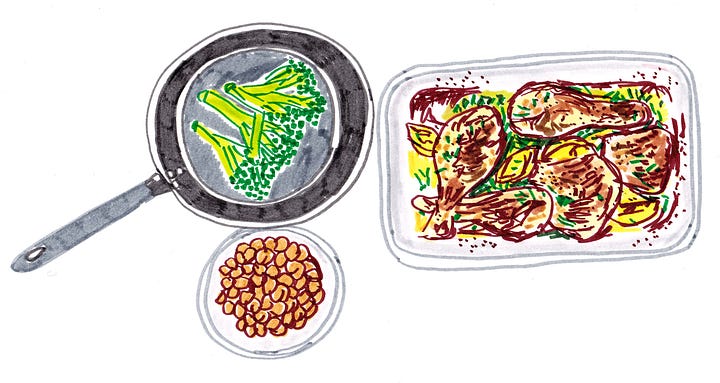
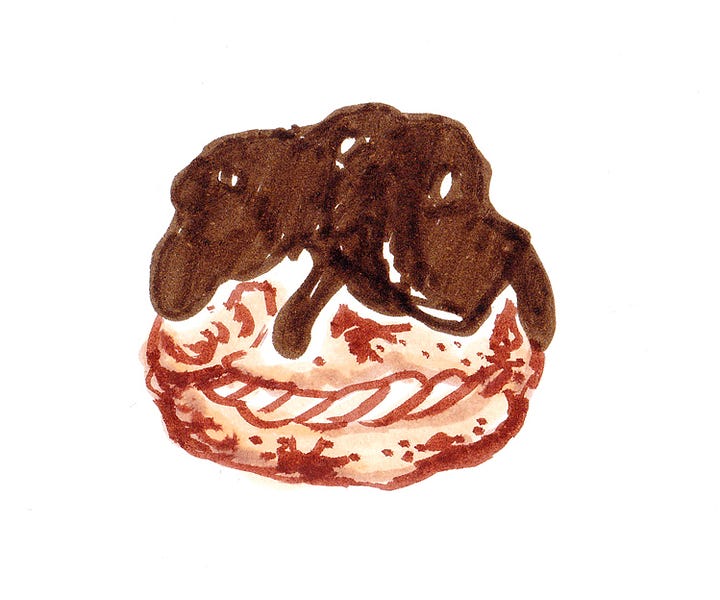
Reena
If I had to go back and cook for my younger self, it would be August 2022, at the beginning of my pregnancy. At my booking appointment, I was diagnosed with gestational diabetes, which shocked me. Four hours at the specialist NHS diabetes clinic at Kings College Hospital on one of the hottest days of the year, I was schooled on the possibility of being Type 2 diabetic, put on Metformin twice a day, given dietary advice, shown how to use an insulin pen and fitted with a blood glucose monitor. It was a lot to digest and I had worried I had already done something to possible affect my unborn baby.
I remember arranging the cupboards at home, one with all the carbs and one without. I tried recipes from a gestational diabetes cookbook; I remember a prawn stir fry with kale that didn't help my evening sickness! My target carbs was 3Og of carbs at each meal and 15g of carbs for two snacks a day. I made a list of recipes I could eat from my existing cookbook collection and looking online for books that could help. I remember making a leek and cauliflower cottage pie from Annie Bell's 'Low Carb Revolution', eating with a portion of tenderstem broccoli on the side and saying to my partner Jack I was so happy to finally feel full.
I attended the next appointment with Jack and realised I hadn't been eating enough carbs. Ketones were showing up in my urine, I had lost weight and I had to up the carbs - I hadn't realised that not eating enough would be a problem. It’s better to eat more than less. I wouldn't know if the diabetes was Type 2 or gestational until after pregnancy and I had to make sure I was feeding myself properly.
I had to relearn how to feed myself again. I added potatoes to the side vegetable topped pies, ate rolled oat porridge topped with fruit and full fat Greek yoghurt, bulked up meals with beans lentils and chickpeas, soy and honey salmon with brown rice and pak choi, swirled wholemeal pasta into courgetti and carrot strands that were topped with lardons, parsley and garlic butter. Apples spread with peanut butter, popcorn, cheese on oat crackers and peanut date bars as snacks. I realised what I could eat without any problems. Bread was something I missed, supermarket bread laced with preservatives and hidden sugars caused peaks in my blood sugar whenever I tried them. I made flaxseed bread and later I discovered that bakery bread gave normal enough readings. I found I could treat myself to the occasional dessert after a meal without a peak, but day to day kept myself to a strict diet. Every week, the diabetes nurses would text me with encouragement, midwives would keep me up to date on things at my appointments and the doctors encouraged more carbs as my pregnancy progressed. I felt lucky to have to have a team advising me and keeping an eye on my baby and me.
Looking back, it's weird to think that two years ago, I was over a month away from my emergency c-section where I'd give birth to our little boy. I was seen at the post-diabetes clinic at six weeks, six months and a year, relieved to have a normal blood sugar (HBAC1) result in them. Gestational diabetes spooked me but also gave me a chance to introduce more foods and recipes into my repertoire.
What would I cook my younger self in August 2022? I would cook a recent chicken dish I've made that is influenced by a roast chicken we have been making at home - traybakes are nice and easy when you're tired. I like this with a spoonful of béarnaise sauce to dip your chicken in and a plate of chocolate profiteroles for dessert because it's nice to have a little treat. I know now I could have a dessert after balancing my carbs! This is a recipe that is specific to my gestational diabetes needs at the time.
This serves six, so I’d have a portion left over for lunch the next day.
Chicken with tarragon, lemon and garlic with chickpeas
Six skin on chicken thighs or a mix of thighs and drumsticks
4Og unsalted butter
Handful of chopped tarragon
Zest of a lemon and juice
Salt
A can of chickpeas
1. Preheat oven to 16OC fan/18OC
2. Mash the butter with a handful of chopped tarragon and the zest of a lemon. Rub under the skin of the chicken thighs.
3. Place the chicken in a baking tray and squeeze over the juice of the lemon. Add the squeezed lemon halves to the pan.
4. Season with salt and pepper and bake in the oven for 4O mins.
5. Cook some broccoli and heat up the chickpeas.
6. Once the chicken is done, add chickpeas to the plate, top with the thighs and drizzle over the juices from the pan. Top with chopped fresh tarragon with broccoli on the side.
Reena Makwana produces illustrations using embroidery, objects, drawings and print. Her work is influenced by the city, characters, food, creatures, social past and present. You can find Reena’s online shop on Etsy.
Sarah
I grew up with beige foods in a town founded on oats: potatoes, croutons, breaded chicken, and meatloaf all reigned supreme. As a child, vegetables were a curiosity on the edges of a plate, certainly not something I dreamed of as a mainstay. I was never taught to cook, nor did I really ask (I tried, but often with errors). If I were to cook anything for my younger self, the girl who didn’t know a salad at age 10, I think it would be the dish I learned to make while living in Belize.
On two-month-long archaeological work trips, my team would live at Martz eco-farm with the Martinez family, located in the jungle outside of San Ignacio. There, Miriam Martinez would lead the cooking at 3 am each morning, in near-total darkness, plotting out mains for hungry archaeologists, and always leaving a dish for vegetarian-me. With the abruptness of her German roots, she would direct me on how to properly wash industry-sized pots and pans, dicing green mangoes, peeling cucumbers just so. Miriam taught me a lot about what it means to cook for yourself. One day, when her menstrual cramps got the best of her, she sat down and walked me through how to cook myself a meal, the very one I’d wish to share with my 10-year-old self. It was simple stew, a blend of vegetables she’d grown exclusively at the farm: eggplants, tomatoes, chaya, and ginger.
Chaya and I had a funny relationship, as it sliced my arm open during one of the jungle hikes up a jungle mountain to site. It’s a caustic plant, sometimes known as tree spinach, and brushing against its wild (not farm-grown) prickled parts led to the white sap eating into my skin, a burn only fixed by the balm of another tree’s wet insides being placed directly on it (the name of that one lost to me with time). That I learned to cook the plant that caused me harm was a testament to circular eating and living. I feared chaya but adored its nutty, umami tastes. While it’s known to some as miraculous, its preparation is specific—eating raw means risking poison, thanks to its hydrocyanic acid.
I so desperately sought to recreate it when I returned to Canada, but without chaya, the particulars of its flavours don’t ever feel quite right. But this dish represents a lot of important histories, ones that I would love to share with my younger self as she dreamt of vibrant foods and places. Supplanting the creamy neutral breaded foods with a caustic chaya, eggplant, and tomato stew, one rich in iron and vitamins, would be such a boon. To show my younger self the possibilities of the future, that come complete with vegetables and strong women and new pathways, I think would embolden her to embrace the complexity of life a bit sooner.
Sarah Duignan is a medical anthropologist, environmental consultant and podcaster. She writes AnthroDish essays on Substack and produces the AnthroDish podcast, which explores the connections between food, health, environment and culture. Sarah and I once chatted about food in fiction too.
Stefanie
“What would you cook for your younger self?”
I wouldn’t cook you anything my love, you’re not good at it. You don’t like it.
The question got me thinking about Glasgow. A city we’ve been in since we were 20.
And it made me think about eating out.
And it made me think of our ex.
You’ve not met him just yet, my love.
You meet as students in halls. You feed yourselves tofu puffs and noodles that you get as you nip next door to Chung Ying. And the tins of coke are 33p. Saying tin instead of can sneaks into your words without you even realising, thanks to the little Northern Irish lilt from him.
And you become vegetarian.
Well, pescatarian.
You eat ‘tuna naan melts’ (tuna, naan, grated cheese and then grilled), share £1 oysters in A’Challtainn, drink tea and scoop baba ghanoush in Tchai Ovna, wolf down £4 veggie burgers in bloc+, whatever is on the special board in Stereo before a gig. And always so many pints.
Too many pints.
10 years of growing to love the city through the food we find whilst eating out.
But you grow tired of him.
But not of this Dear Green Place, my love.
Locked down, you treat yourself to your daily solo breakfasts; massive pastries, fancy orange juice from your closest supermarket, porridge with raspberries and Cadbury’s buttons and your new cafetière with coffee you order from Gordon St. And still not cooking.
Buying tins of booze you don’t touch.
Still rarely touch.
You bake a layered cake with piped icing and cherries on top to share with the friends you meet for the first time offline. And your close friendships deepen and that long tinder list shrinks quickly with hot coffee and cold bums on the metal benches at the very tip top of kelvingrove park.
And now dear, the grass is a little greener, in his place.
Southside.
You’ll find love outside of yourself, my love.
Someone loves you.
You.
And you chop veg and do the dishes beside other people, maybe getting a little closer to cooking, my love.
Stefanie runs the Feminist Book Club Glasgow and writes Biggest Slut at the Local Library on Substack, an exploration of how she uses books and reading to learn and share and process the world.
Steph
If I could eat a rainbow
Growing up, life echoed the beige of food at home; paler than it should be, of mince, slightly over-boiled cauliflower sapped of life, pastel broccoli, even emaciated carrot!
Vegetables were always secondary or tertiary; I never revelled in them, talked about them, fetishised them or took photos. Nowadays, I take more pictures of sexy veg than the people I love; more fruit than selfies!
Sure, I cherish memories of being tiny whilst sitting at my grandparents' formica-topped wooden table, my legs swinging from a tall stool, helping to top and tail broad beans. Yet, I don't recall eating them. I wasn't aware they had a more mature name and variation—fava beans—and were given a little more respect in other countries.
My personality wasn't beige, though. I loved colour, and I could also be quite loud. I was enamoured by a bright cartoon-patterned jacket my mum bought me and excited to grow into it. But moving from England to Scotland may have dulled me. My Scottish peers didn't like the jacket and didn't much appreciate my northern tones.
As a young student, I could feed myself, compile a decent pasta dish, and coax a roux into a respectable béchamel sauce (also beige!). I fared well on a small budget in my Hillhead Street student flat, carefully allocating around £8ish-a-week as a food allowance so I could prioritise more 'essential' expenditures—vodka and Red Bull, £1 beers at the student union (Stella mostly; I didn't like Tennants), and shiny, studded wide-legged Diesel jeans.
I adored my hooded terry-toweling shirt from Concrete Skates. But vegetables didn't register. I have no memories of buying vegetables other than potatoes and onions at the supermarket. I knew that Roots, Fruits and Flowers on Great Western Road was an admirable institution, but I don't remember ever going; I never selected things by weight or coveted things grown in soil for their beauty. Never chucked a pile of stuff in the oven to roast and reuse another day. As I grew older, I became more aware of the spectrum of possibilities. Beauty. Pleasure. Taste. Eventually, I got an organic veg box. Later still, something shifted. I started seeking out colour, anthocyanins— pigments that paint the natural world in deep purples and blue, craving vibrancy on my plate as much as in my wardrobe or on my walls at home.
Now, I work as a greengrocer. Meals are curated hyperseasonally. I adore the bougiest vegetables and love wearing cheesy fruit and veg-themed tees under my work apron. Interest in fashion is long gone. My tote bag flashes a bright pink stain of stewed rhubarb. If I could cook for my teenage self, I'd set the oven to 180 degrees, grab a baking tray, flaky Blackthorn salt, and drizzle EVOO over a patchwork of vegetables.
Cooking and food prep usually involve roasting the contents of my fridge and fruit basket on my day off, clearing the way for the next week. My staple quick dish at the moment is orzo with a selection of roasted veg. I like to toast the orzo and then fry in garlic olive oil before adding water and a spoonful of grape tahini to add depth. Since I cooked from Sami Tamimi and Tara Wigley's recent book Falastin, I've kept a mortar and pestle full of crushed fennel seeds and cumin on hand, a flavour combination I wish I'd used earlier. Often I turn the pot off before it has fully finished cooking to let the orzo soak up everything in its own time. Some veg I add while boiling the orzo and some after. If I could eat a rainbow:
RED: Long, glossy red peppers, fiery chillies chopped with precision
ORANGE: Sweet carrot with fragrant crushed fennel and cumin seeds
YELLOW: Tiny toasted grains of orzo, walnuts adding earthy warmth
GREEN: Fresh, flat-leaf parsley, finely chopped and sprinkled
BLUE: My soul, yearning for nourishment, salt
INDIGO: Deep purple carrots, grape tahini melting into the pot
VIOLET: Roasted scored aubergine, skins slick with olive oilA rainbow, and I am happy.
Steph Marsden is a designer/food systems nerd turned greengrocer from Edinburgh, Scotland. She writes about food on her Substack newsletter Amuse.
thank you for reading this special edition of The Onion Papers. i’m margaux, an interdisciplinary writer and cook, and this is my hybrid newsletter. you can subscribe and come back for seconds (Thursdays are for long reads and Mondays for annotated recipes, both come out every other weeks) <3
Kitchen Alphabet
Allegories become tidal in the kitchen, as free as water, as polyphonic as a recipe. a school of empathies for compassion to sprout.


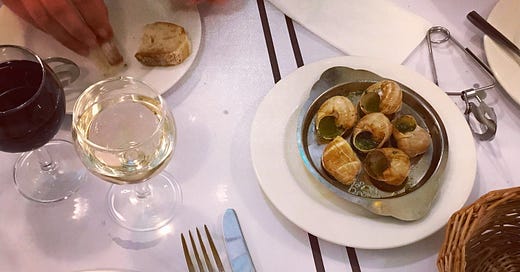



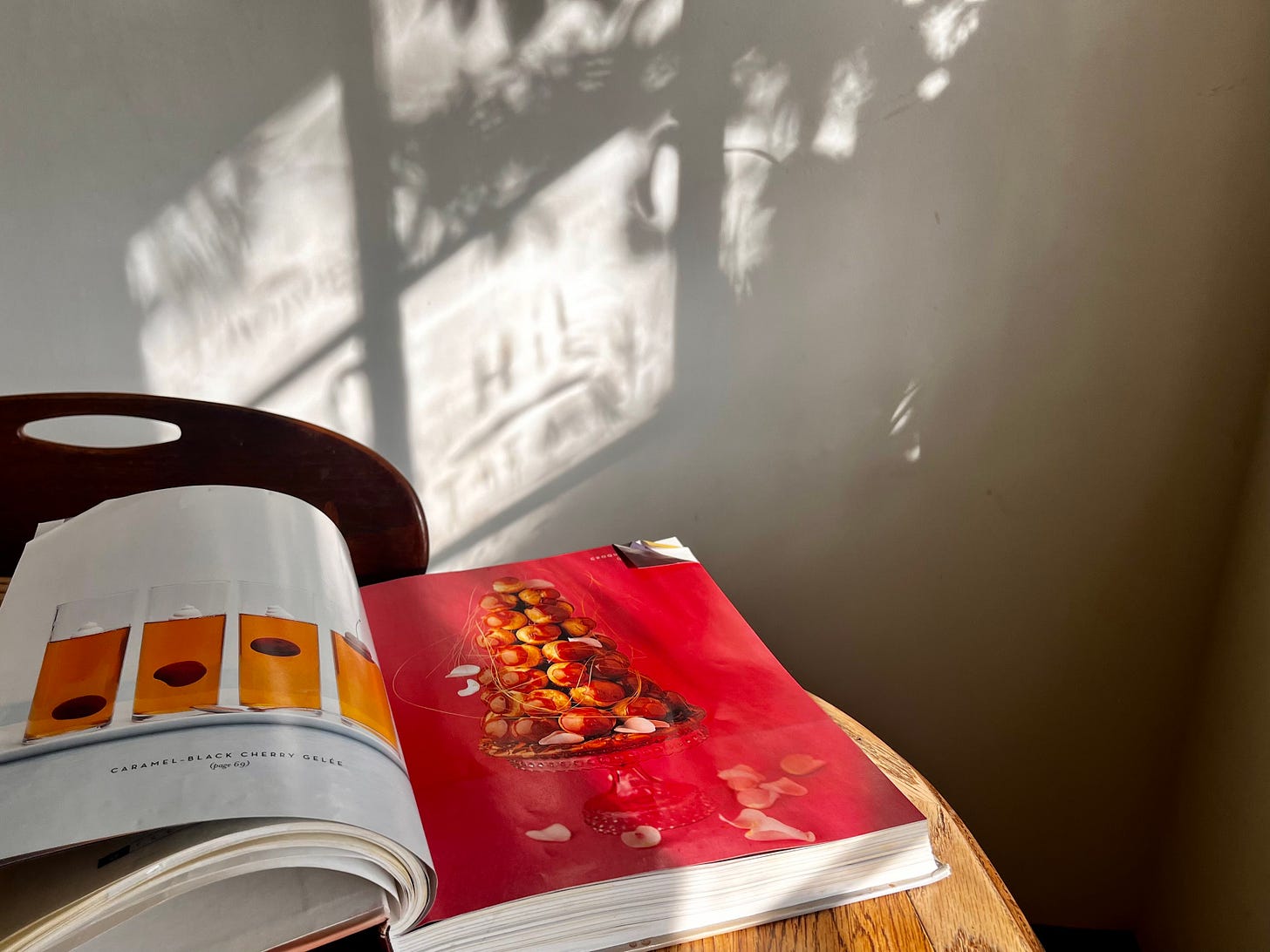
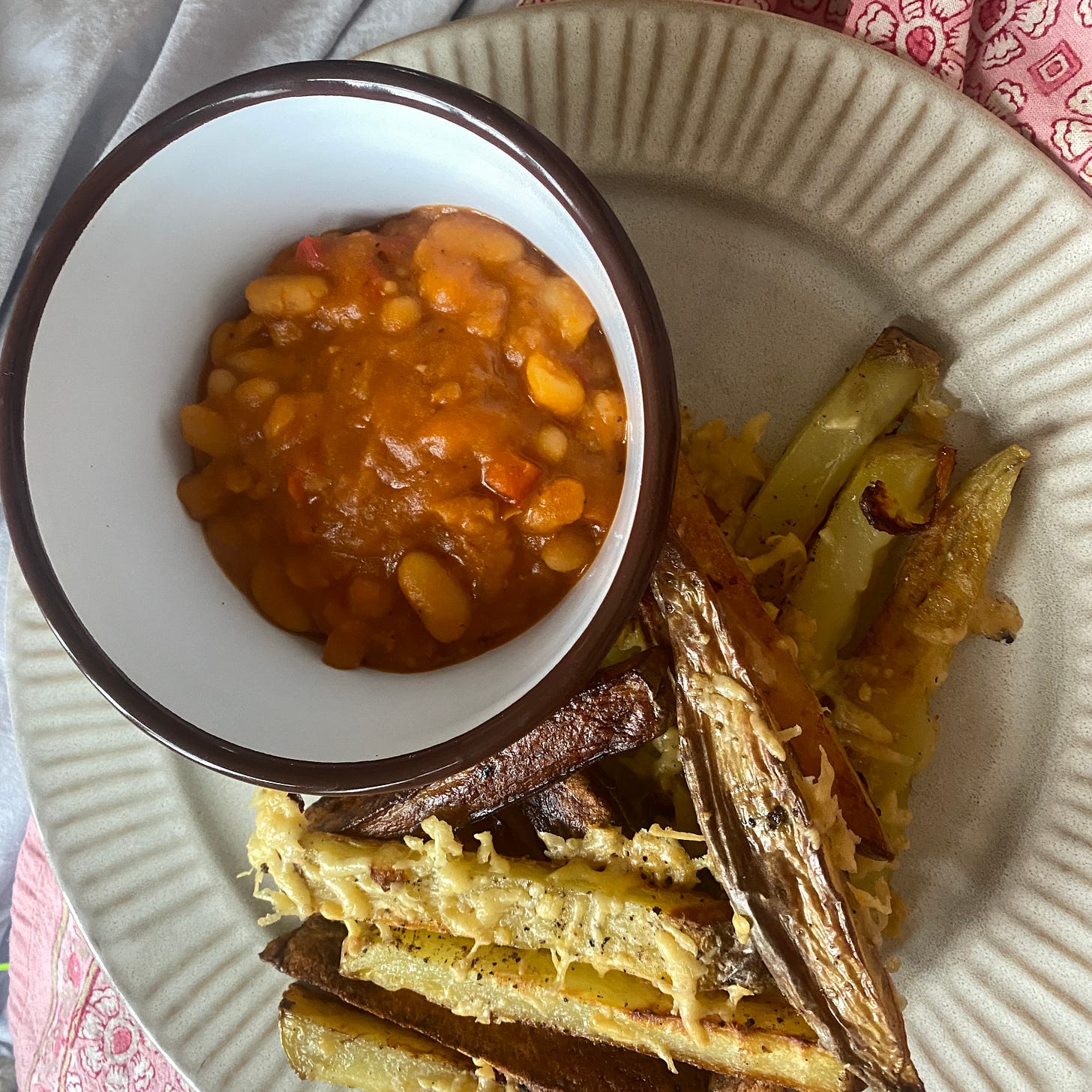
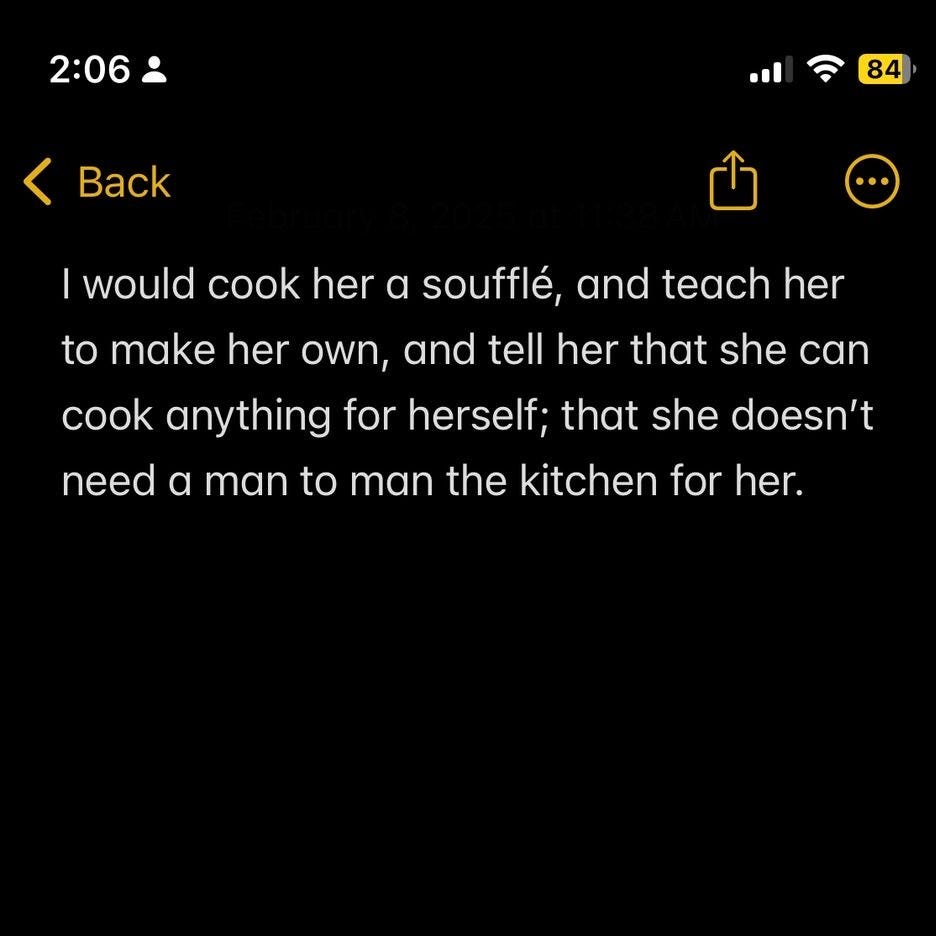
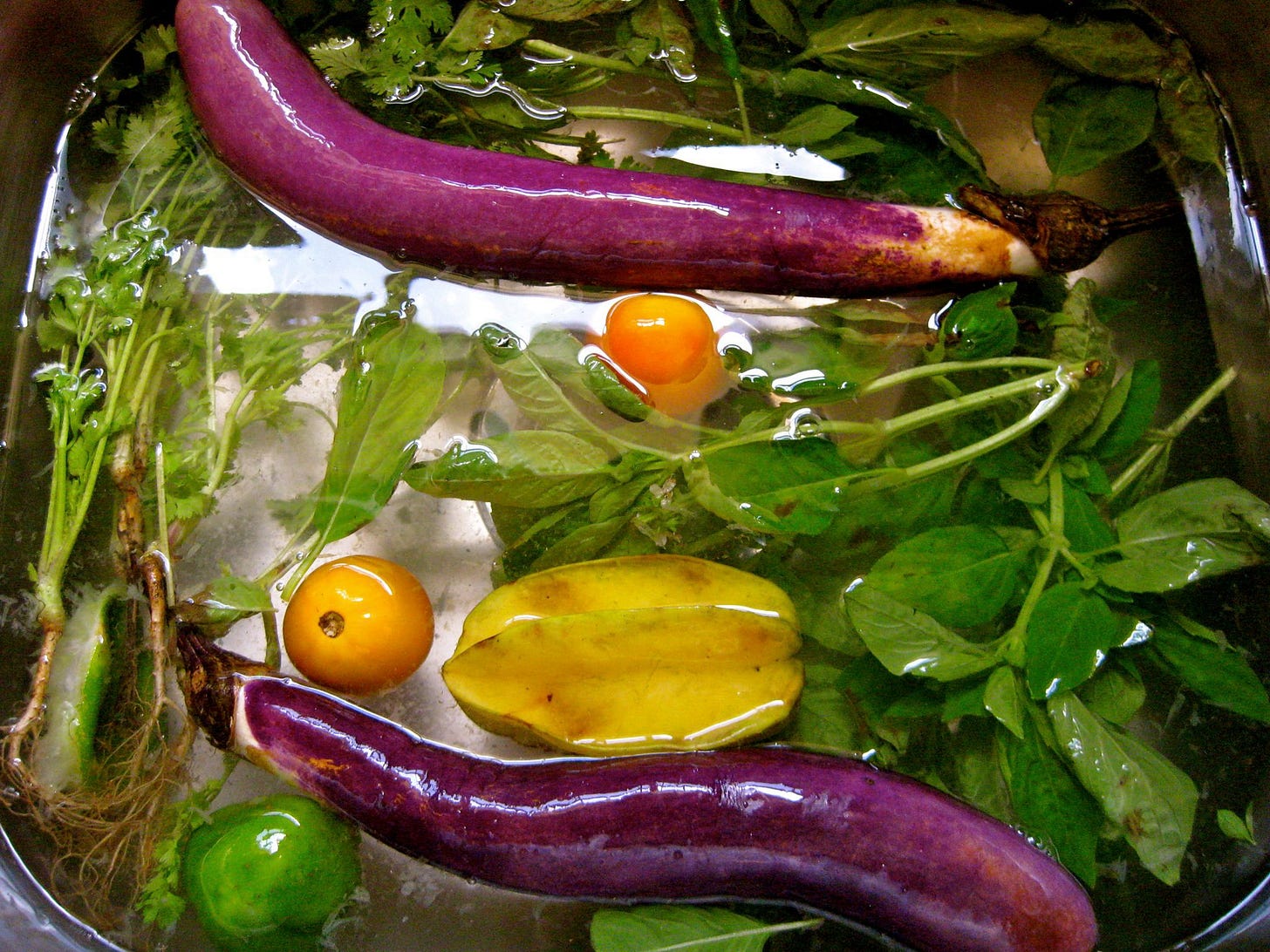


all of our memories, like a glittering constellation! happy paperback day!!
What a beautiful collection of voices!! Happy paperback day, Margaux!